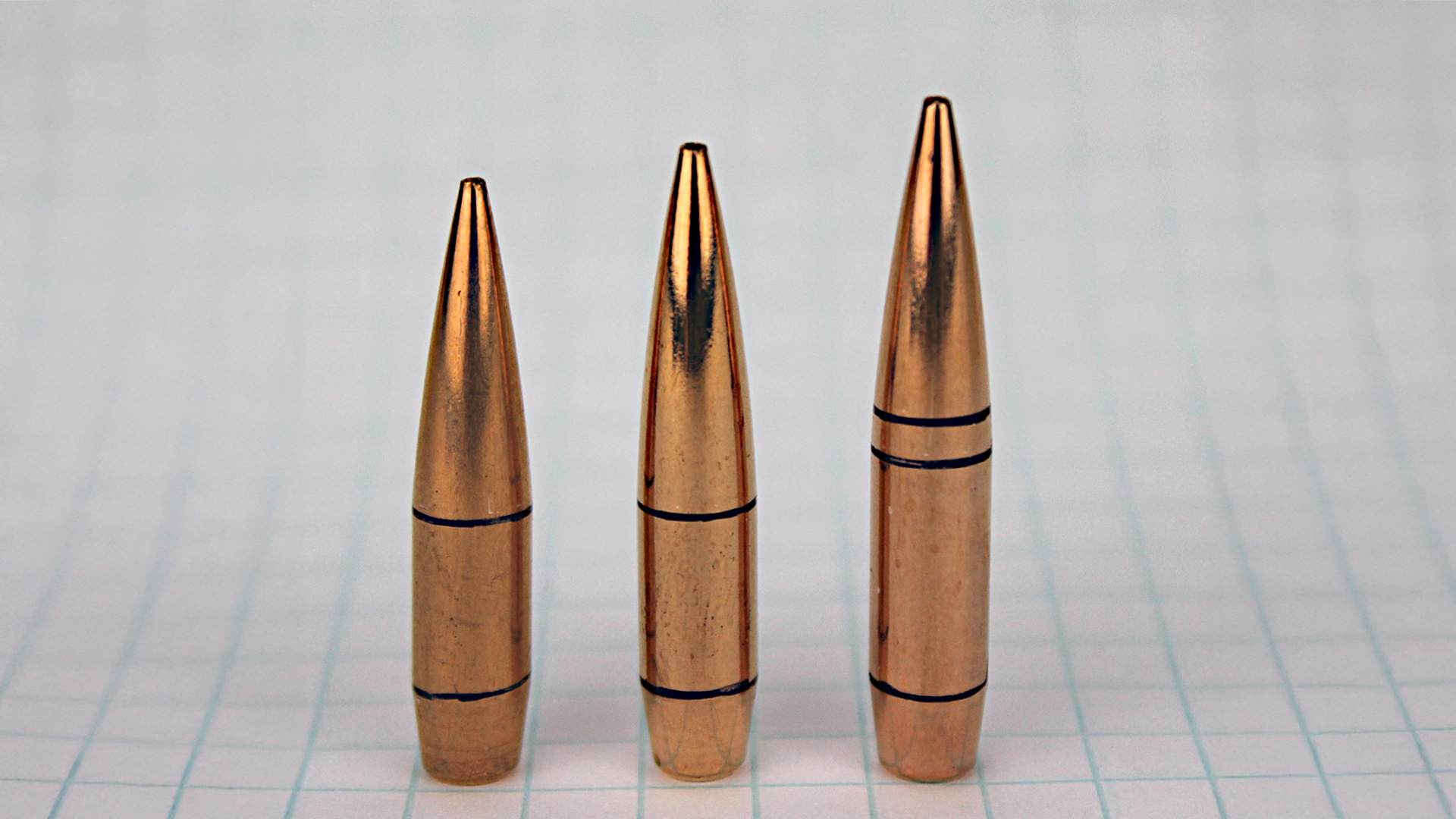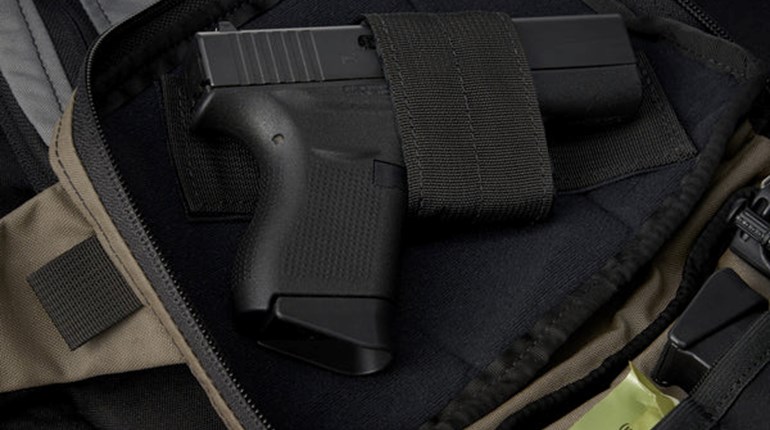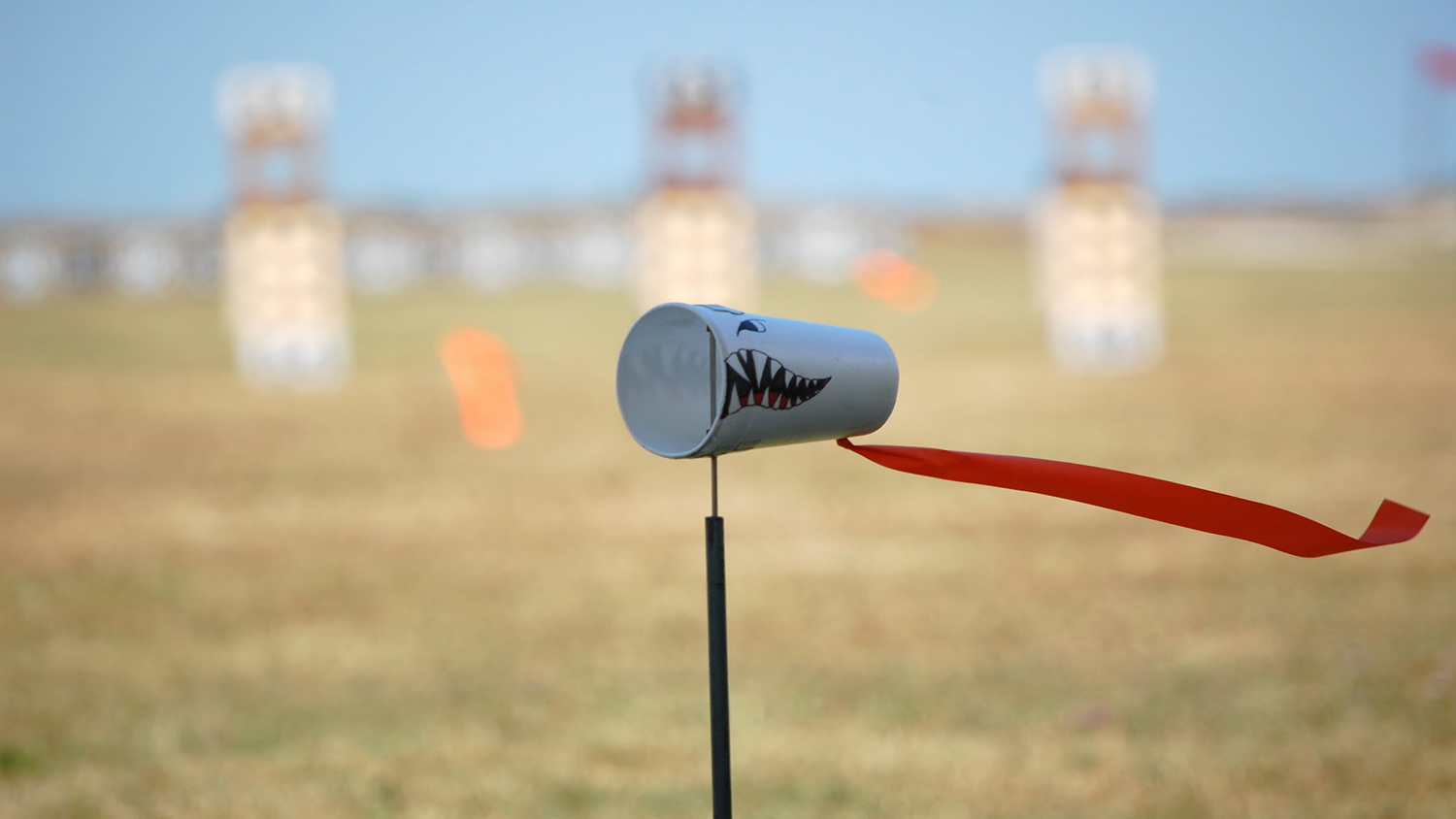
From the March 2011 issue of Shooting Sports USA.
SightsThere are some fundamentals of sight adjustment to review before discussing wind and mirage. For this initial discussion, let’s assume we are on an indoor range with no wind or mirage.
Sight Adjustment
As you know, when your rifle is not canted and you move one of your sight knobs, you are either moving the point of aim up/down or left/right. Most shooters, however, cant their rifle as a necessary practice to adjust the rifle to fit the shooter’s position, rather than fitting the shooter to the rifle. It is imperative that the degree to which the rifle is canted be exactly the same for each shot. To accomplish this, smallbore shooters use a spirit level to monitor their cant angle.
Effects of Cant on Sight Changes
In this right hand example, we will assume that the top of the hook butt plate is moved from 12 o’clock to 1 o’clock, while the bottom of the hook butt plate remains at the 6 o’clock position. Placing the butt of the rifle into the shoulder and keeping the hook in the same position, straight up and down, results in the rifle being canted to the left with the cheek piece pushing into the shooter’s cheek. With the rifle so canted, a windage adjustment to the left not only moves the shot placement to the left, but also down.
Likewise, when we adjust this sight’s elevation downward, we are also making a small change in windage to the right. The greater the cant, the greater amount of elevation and windage change will occur. With some sights, the shooter can adjust the sight so that it remains level, thus avoiding the effect of cant. In my experience, most people either don’t have such a sight or don’t take advantage of this feature.
From this point on we will consider shooting outdoors and dealing with the effects of wind and mirage.
The Bernoulli Effect
The Bernoulli Effect explains the relationship between air speed and pressure. Consequently, as wind picks up from the right, the bullet pattern will move to the left and higher. If wind is blowing from the left, the pattern will move to the right and lower. This produces the 10 o’clock to 4 o’clock pattern in the diagram above.
So we need to take cant and the Bernoulli Effect into account even before we think about wind and mirage.
Wind
With wind, we need to assess both direction (angle) and velocity (speed). International-style ranges generally do not have bushes, long grass or dust to indicate wind effects. That means that we are limited to assessing wind direction and velocity from range flags and mirage.
At this writing, International rules require flags to be placed 10 and 30 meters from the shooter toward the target and on every firing point. Wind velocity is relatively easy to assess by watching the flags. You can see wind pick-ups and let-offs as well as determine a predominant condition by studying the flags. Assessing the direction of the wind is more challenging.
There are several areas on which to focus to determine angle. The distance from the flag stand to the end of the arm is fixed. So, as the wind changes in angle, for example from 3 o’clock to either 1:30 or 4:30, the length of the horizontal rotating arm appears shorter. It is even more challenging to determine if the angle is toward you or away from you. Looking at the arm of the flag, if the point of attaching the flag to the arm appears to be larger or closer, then the wind is coming toward you. If it appears smaller, you know the wind angle is away from you. Also, if the flag appears bigger, the wind is blowing into you and if the flag appears further away or smaller, the wind is blowing away from you. These are subtle changes, but you can and need to train yourself to pick up on them. This isn’t easy, but with training it can be done consistently with accuracy. I can tell you the best shooters do this with accuracy, all the time.
As a wind flag becomes saturated with water, the flag becomes heavier and requires more wind to move the flag. So, in rainy conditions, keep in mind that the amount of wind required to move the wet flag to the same point as in a dry condition is greater. One advantage of rain is that it is a good indicator of wind direction and velocity. In short, we are saying to use all available indicators to assess wind direction and velocity and to use them according to the changing conditions around you.
One question asked over and over is to look at a range flag and ask how many sight adjustment clicks that condition is worth. What might be a click or two on one range may be different on another, based on terrain and other factors. With this in mind, one size does not fit all. In other words, a condition that may be worth one click on one range may be worth three clicks on another.
There are four basic methods of shooting in the wind: (1) pick a condition in which to shoot, (2) estimate a new wind velocity and make sight corrections, (3) a combination of these two methods, and (4) chasing the shot. The critical factor in all four methods is to know your zero and how the zero is affected by what goes on around you. The most desirable method is the first: picking a condition. This method has the fewest number of variables since you only shoot when all conditions are exactly the same as the one you picked.
The one disadvantage of this method is that it can require a great deal of time. The second method—estimating wind direction and velocity and correcting for their changes, is also a popular method. The disadvantage of this method is that you are shooting in more variables and your estimation had better be correct. Learning to estimate accurately requires a great deal of shooting experience. The third method—pick a condition and estimate any changes, is more complex and makes it a bit more difficult to know your exact zero. The difference with this method is that you are shooting within a range of conditions and changing your sights, rather than using a single condition. You are shooting outside of the “predominant condition,” and shooting through a range of wind changes that you find acceptable. Finally, there is the “chasing the shot” method. This is a plan of desperation and normally used when you are running out of time and making sight adjustments based only upon the print of the last shot.
We will cover game plan in a moment, but one thing a shooter should never do is to make the decision to give up on his/her game plan of predicting the shot and shooting through all conditions. This is a losing effort, as the shooter has no idea of the impact of the elements from shot-to-shot on where the bullet will print on the target. This is elementary school thinking. Never just give up and shoot through everything.
I’ve often heard it said that wind reading is a game of luck or chance. I believe good wind and mirage reading and prediction is a learned activity. Although luck or chance play an important part in all our lives, I tend to agree with the thoughts of Louis Pasteur: “Chance favors the prepared mind.”
Quadrant Shooting
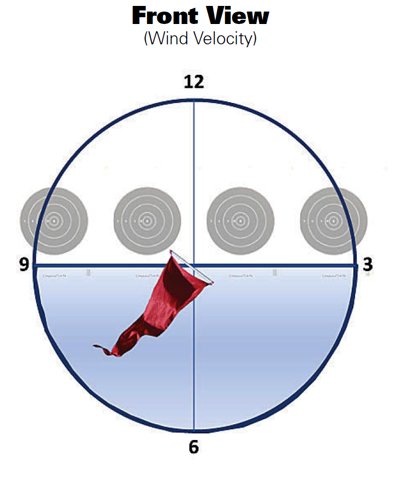 Top shooters use two quadrants to identify the dominant wind condition in which they will shoot: A front view to determine the wind velocity and a top view to measure wind direction (angle). Fire record shots only when both quadrant angles match your dominant condition. When looking directly at the wind flag (front view), the flag will generally move within a 90 degree arc between the 9 o’clock and 3 o’clock positions. The predominant quadrant would be the condition in which the flag is most often blowing. While determining the predominant condition, the shooter would select either the right or left quadrant in which to shoot and would avoid shooting when the flag is in the opposite quadrant. The shooter is using the technique of looking directly at the flag (front view) to determine velocity of the wind. It is also important to determine the angle, or direction of the wind using a top view.
Top shooters use two quadrants to identify the dominant wind condition in which they will shoot: A front view to determine the wind velocity and a top view to measure wind direction (angle). Fire record shots only when both quadrant angles match your dominant condition. When looking directly at the wind flag (front view), the flag will generally move within a 90 degree arc between the 9 o’clock and 3 o’clock positions. The predominant quadrant would be the condition in which the flag is most often blowing. While determining the predominant condition, the shooter would select either the right or left quadrant in which to shoot and would avoid shooting when the flag is in the opposite quadrant. The shooter is using the technique of looking directly at the flag (front view) to determine velocity of the wind. It is also important to determine the angle, or direction of the wind using a top view.Mentally picture the quadrants from a “helicopter view.” However, this time change the quadrants to 1:30 to 4:30, 4:30 to 7:30, 7:30 to 10:30, and 10:30 to 1:30. It is important to determine the angle of the wind by developing a mental quadrant picture.
Narrowing the Quads
Successful marksmen may not utilize these exact terms to discuss wind prediction, but they all use these processes. The most successful marksmen utilize quadrant shooting. However, they narrow the quadrants down significantly so that, instead of shooting in a 90-degree arc, they may shoot in only a 30-degree arc. A 30-degree arc is equal to one hour on the clock, i.e. 6 to 7 o’clock, for example. While the discussion so far has addressed a quadrant of 90-degrees, utilizing such a large area would be shooting in “too much wind,” which translates into taking excessive chances. Successful shooters select a smaller area of the arc as their predominant condition.
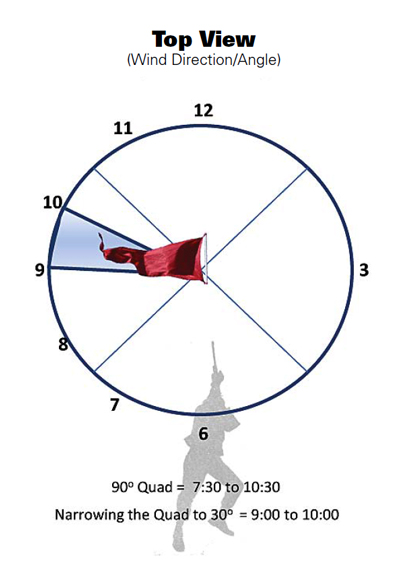 Wind is usually not in a zero condition. Many shooters may initially select their arc to be 7 to 8 o’clock. In order to judge angles in the other quadrants, they may select 8:30 to 9:30 as their arc to better judge direction. The point of this is that the most successful shooters use the quadrant method. They also reduce the size of the quadrant so that they are shooting in more consistent conditions. The smaller quadrant also allows them to more accurately predict the placement of the bullet on the target because they are shooting through fewer angle changes. Being successful with this method requires the athlete to determine when to shoot in one of two quadrants. The shooter selects the quadrant with the predominant condition and determines the velocity in which to shoot. The shooter then selects the angle to shoot in by determining the predominant condition of that quadrant. Lastly the shooter must develop the discipline to shoot only within those quadrant arcs.
Wind is usually not in a zero condition. Many shooters may initially select their arc to be 7 to 8 o’clock. In order to judge angles in the other quadrants, they may select 8:30 to 9:30 as their arc to better judge direction. The point of this is that the most successful shooters use the quadrant method. They also reduce the size of the quadrant so that they are shooting in more consistent conditions. The smaller quadrant also allows them to more accurately predict the placement of the bullet on the target because they are shooting through fewer angle changes. Being successful with this method requires the athlete to determine when to shoot in one of two quadrants. The shooter selects the quadrant with the predominant condition and determines the velocity in which to shoot. The shooter then selects the angle to shoot in by determining the predominant condition of that quadrant. Lastly the shooter must develop the discipline to shoot only within those quadrant arcs.Mirage
Mirage is a distortion of light caused by alternate layers of hot and cool air; those “little wavy lines.” Better yet, mirage has been referred to as “wind that you can see.”
With the advent of electronic targets and a monitor to see your shot, many shooters no longer use a spotting scope. This is a huge mistake, as you cannot see the mirage without a scope. To see the mirage, focus the spotting scope on your target and then back off or move the focus nearer so that you are focused in front of the target. The target will appear blurry, but you will still be able to see your bullet holes. Aim the scope at the target or target frame so that you can see the wavy lines. The mirage is constantly moving based on the direction and velocity of the wind. Remember, it is “air we can see.”
Some of the best shooters in the world have told me that they will not use a spotting scope at certain complexes because they can’t see any mirage. However, they may use a spotting scope on that same range later in the year, when the mirage can be seen. My belief is that, even if you can only see mirage for a few shots, you are better off having that additional information to make your sight change or shot selection. It only takes one missed condition change to fall from a 600 to a 599.
Because air weighs so little, the mirage will change before the wind flags move. That means that by studying the mirage during the course of a match, you will pick up more changes, sooner, than by just looking at the flags.
As wind speed increases, the mirage will flatten out at about 15 miles per hour. Unfortunately, mirage is of little value at this wind speed or greater. From a zero wind condition, if the mirage picks up going to the left or right, your shot will move in the same direction.
From a zero condition, if the mirage begins to “boil” (going up as opposed to left or right), your shot will go high. And should the wind change and come into you, your shot will go low. With any of these examples, the amount that the bullet print changes on the target depends on the velocity of the wind.
Championship Shooting
When you shoot a shot, what is it that you are trying to hit? Your answer should be a center 10. Focus on shooting the center of the 10-ring, not just shooting a 10. If you sight in and you are shooting scratch 10s, your shots are on call and you make the decision to go for record, you have given your competitors a huge advantage. If you go for record and the smallest thing changes, you are probably now shooting a 9 just outside the 10-ring. If you were sighted in to the center of the target, you have half the 10-ring in which small changes can take place and still be able to shoot a 10. Do yourself and your teammates a favor; get sighted into the center of the 10-ring.
Ten to 15 minutes prior to the beginning of the match, study the predominant wind condition you plan to shoot in. This is developing a game plan for your match. If you get into position and then begin these assessments during your sighter shots, you are behind the power curve and at a distinct disadvantage from the start.
In your preparation period, establish your position; get your natural point of aim, dry fire to insure your position is correct and that you are technically and mentally ready to shoot. Do that prior to the “Start” command and prior to shooting your first shot.
The sighting target is to be used for two things; to sight your rifle in for the predominant condition and to test wind conditions to see what effect a condition change will have on the point of impact. Do not use your sighter to find your position.
Make as specific a shot call as possible. An example call is a “scratch 10 at 10 o’clock.” You need to include both the clock direction and the score value, not just call a 10 or a 9. This is critical in order to know your zero and to make changes.
Shot Calling/Adjustment Sequence
- Fire the shot and follow through while calling the shot.
- Check the flag and mirage (Should your placement expectation change?).
- Check the monitor to observe the actual clock (direction) and value of the shot.
- Make any sight changes.
- Finish loading and check the mirage and flag again as you assume your position.
- In position, check the flag again (if you can, from behind your sights), then shoot when ready (6 to 8 seconds).
- Repeat the process.
Why should you utilize this sequence? Wind and mirage reading is a process of predicting where the shot will print versus your shot call. This takes into consideration changes that may have occurred since you last observed, compared to where the bullet actually prints. So you want to understand what the wind and mirage are doing as close to your shot as possible. This information allows you to determine if there is a reason the bullet should print or not print on the target in the place that you have predicted. Wind and mirage constantly change. All changes make a difference in your assessment of making or not making sight changes to maintain your zero.
Establish an efficient and comfortable shot cadence, often called rhythm, from the point the rifle goes off until the next shot is completed. It is a measure of time. Because the wind and mirage are always changing, it is to your advantage to have fewer element changes to shoot through. In other words, the longer it takes you to shoot a shot (and a match), the greater the number of conditions you will shoot through. The point is not to shoot as fast as you can, but to complete the sequence efficiently. Don’t take three or four seconds from firing the shot to the point of lifting your head. Don’t take another three or four seconds to look at the flag and then open your bolt to reload. Don’t take yet another three or four seconds to put a bullet into the chamber. Take the time you need, but don’t waste time in the process. The advantage of efficient time use is that you understand the conditions better, you shoot through fewer condition changes and you are not in position so long that the pain you experience takes away from your ability to concentrate.
There is a saying in the Army: “Train as you will fight.” Let’s apply that to our sport and change it to: “Train as you will compete.” There are two basic premises in this saying. First is the process of shooting. Sometimes athletes want to take shortcuts and they do things differently in training because they are lazy and don’t want to work that hard. They say they know what to do in the competition and they’ll do it then. The athlete may not say this out loud, but inwardly they are saying it to themselves. Well I’ve got news; under pressure and on demand, an athlete will most likely replicate what they have done in training, as it is a learned behavior. Having a lazy work ethic in training but an expectation of a high performance in competition is a recipe for disaster. The competition performance reverts back to the learned behavior in training.
The second premise in “train as you will compete” is intensity. This again goes back to an athlete’s choice. Lazy athletes will give perhaps a 70 percent effort in training and then on match day expect that they will perform at 100 percent under pressure, on demand. This doesn’t happen except by accident. Do people sometimes have great performances with terrible training habits? Yes, accidents happen. However, do you want to achieve by accident or do you want to achieve on purpose? Training should be focused; putting forth full concentration; goal oriented; and organized. And the training must be consistent to build the learned behavior required to produce high-level intensity. Process and intensity through repetition become learned behaviors, which become positive habits in successful athletes.
Always work from true zero. When sighting in, always know what your sight setting is in relation to true zero (no wind). Regardless of how conditions change through your match, keep in mind what the sight setting would be in a zero condition. In that way you will always be doping and predicting the value of the wind. It will help you stay on top of your condition and you will know exactly where your sights are in relation to the condition in which you are going to shoot.
Recently I heard shooters use the term “dead time.” Having never heard this term before I asked what that meant. The answer was something like, “You know, it’s the time that you have when your condition changes and you are waiting around until the condition comes back. You aren’t doing anything or thinking anything. Dude, its dead time.” I was shocked at this statement. I’ve also had shooters tell me they lose focus during this time and their cadence is different due to an extended period of waiting for their condition to come back. Cadence in outdoor shooting, as opposed to indoor shooting with no wind and mirage, is different due to the additional time the athlete is waiting for their condition to return before shooting the next shot. However, top-level athletes are always “mentally busy.” They have no “dead time.” Shooters that have dead time are missing important information concerning conditions that are necessary to continually keep track of their true zero. In addition, if an athlete allows himself to mentally let down during the “dead time,” he/she is probably not at the same high mental level when their condition returns and must quickly execute the shot. A constant high-level mental performance is advantageous to producing a high-level performance outcome (score). Achieve on purpose, not by accident.
The Game Plan
A game plan is a plan you develop, detailing what you are going to do in the match and how you will handle variables. Before the match begins, you should mentally identify the predominant conditions; predict the variations that you can expect to encounter; and determine your plan to handle those changes. Your game plan is a road map with a variety or routes for you to follow depending on how conditions change or don’t change in the match. Your game plan will provide a planned solution when adversity strikes during a match. Rather than panic, you will simply make a confident mental shift, executing a different plan that deals most productively with the changed condition.
A game plan is essential. Many shooters at local matches walk up to the line, lie down and start shooting. This is done with no thought of what they want to do or how they will do it. Normally, these are not the folks who will be on the podium. Before the match, I outline all the variables that could possibly happen and the best way to react to each. When I walk up to the line I know exactly what I am going to do and what the best, most logical course of action would be should circumstances change during the match. Prior to the preparation period, I assess all conditions—wind velocity and direction, mirage, or anything that will assist in determining the predominate condition. I then formulate how I will fire that particular stage of the match. When the command “Start” is given I’m already ahead of 90 percent of the firing line. At the world level of competition, everyone has a game plan, except the person that is not prepared to win.
Absolutely Necessary
There is one final and very important point to keep in mind concerning shooting outdoors and dealing with the elements. The shooter must master wind and mirage reading to be consistently successful. However, having said all of the above, nothing takes the place of a well-aimed shot.
The great U.S. prone shooter and scholar of the sport, George Stidworthy, propounded several of the concepts in this article. William Beard kindly provided editorial review.
Editor’s Note: Ernie established and continues to hold the national record for the Critchfield course-of-fire consisting of 1600 iron and 1600 any sight shots with a score of 3200-301X. He was the Smallbore Rifle Prone Champion at Camp Perry in 1980; fired a world record in the English Match with a perfect 600 in Rio de Janeiro, Brazil, in 1981; was a member USAR Shooting Team from 1982-1994 and won 11 medals and set more than 200 national records in international competition.


























